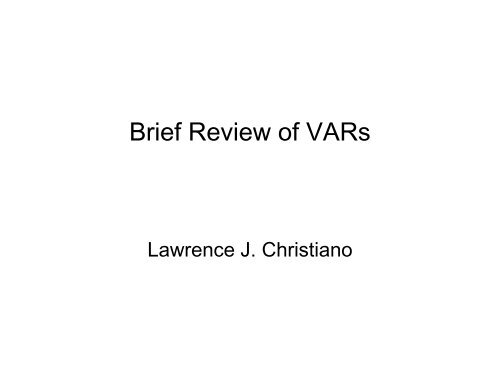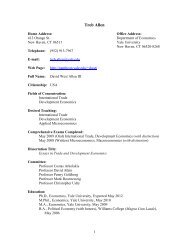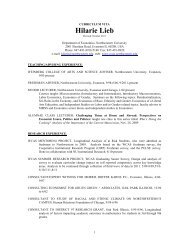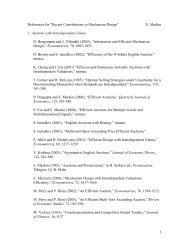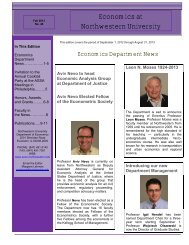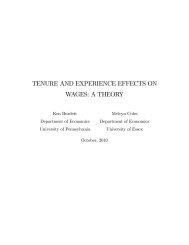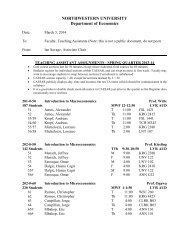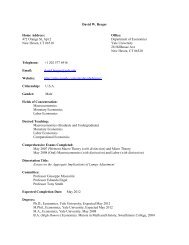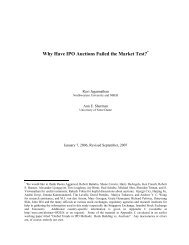Vector Autoregressions
Vector Autoregressions
Vector Autoregressions
Create successful ePaper yourself
Turn your PDF publications into a flip-book with our unique Google optimized e-Paper software.
Brief Review of VARsLawrence J. Christiano
<strong>Vector</strong> <strong>Autoregressions</strong>• Proposed by Chris Sims in 1970s, 1980s• Major subsequent contributions by others (Bernanke, Blanchard-Watson, Blanchard-Quah)• Useful Way to Organize Data– VARs serve as a ‘Battleground’ between alternative economic theories– VARs can be used to quantitatively construct a particular model• Question that can (in principle) be addressed by VAR:– ‘How does the economy respond to a particular shock?’– Answer can be very useful:• for discriminating between models• For estimating the parameters of a given model• VARs can’t actually address such a question– Identification problem– Need extra assumptions….Structural VAR (SVAR).
Outline of SVAR discussion• What is a VAR?• The Identification Problem• Long run restrictions as a way to solve the problem• Short Run Restrictions: Identification of Monetary PolicyShocks• Results• Historical Decompositions of Data
Shocks and IdentificationAssumptions• Monetary Policy Shock• Neutral Technology Shock• Capital-Embodied Shock to Technology
Identifying Monetary Policy Shocks• One strategy: estimate parameters of Fed’sfeedback rule– Rule that relates Fed’s actions to state of theeconomy.R t = f(Ω t ) + e tR– f is a linear functionΩ t : set of variables that Fed looks at.– e R t : time t policy shock
What does this rule represent?• Literal interpretation: structural policy rule ofcentral bank.• Combination of structural rule and other “stuff”• Example: Clarida – Gertler– True policy ruleRR t E t X t1 e t fall time t data used in E Rt X t1 e t
What is a Monetary Policy Shock?• Shocks to preferences of monetary authority• Strategic considerations can lead to exogenousvariation in policy– Self-fulfilling expectation traps (Albanesi, Chari,Christiano)• Technical factors like measurement error(Bernanke and Mihov)
Recursiveness Assumption• Policy rule: R t = f(Ω t ) + e tR .• Problem: not enough assumptions, yet, to identify e tR• Assume:– Policy shocks, eRt are orthogonal to Ω t .Ω t contains current prices and wages, aggregate quantities, lagged stuff• Economic content of this assumption:– Fed sees prices and output when it makes its choice of R t.– Prices and output don’t respond at time t to e tR .• Assumption implies e tR can be estimated by OLS• Response of other variables can be obtained by regressing them oncurrent and lagged e tR
Long Run Identification of TechnologyShocks (Blanchard-Quah, h Fisher, JPE 2007)• There are two types of technology shocks: neutraland capital embodiedX t Z t FK t , L t K t1 1 − K t V t I t• These are only shocks that can affect the log levelof labor productivity.• The only shock which also has a long run effect onthe relative price of capital is a capital embodiedtechnology shock (V t ).• These identification strategies require that thevariables in the VAR be covariance stationary.ti
Technology Shocks…• Advantage of this approach:– Don’t need to make all the usual assumptions required to constructSolow-residual based measures of technology shocks.• Functional form assumptions for production function, corrections forlabor hoarding, capital utilization, and time-varying markups.• Disadvantage: some models don’t satisfy our identifyingassumption.– endogenous growth models where all shocks affectproductivity in the long run.– Standard models when there are permanent shocksStandard models when there are permanent shocksto the tax rate on capital income.
Identification• When monetary policy shocks andtechnology shocks are identified separately,have exact identification– no restrictions on the estimated VAR parameters• When shocks are identified simultaneously,there is over-identificationidentification.• We test this and do not reject.• See Altig, Christiano, Eichenbaum, Linde.
VAR estimation with the following data:The data have been transformed to ensure stationaritySample period: 1959Q1-2007Q1
• We will now estimate impulse responsesusing a VAR.• First, however, we have to talk about thecomputation of standard errors.W ’ll di t d d b t t• We’ll discuss a standard bootstrapprocedure.
Interesting Properties of Monetary PolicyShocks• Plenty of endogenous persistence:– money growth and interest rate over in 1 year, but other variables keepgoing….• Inflation slow to get off the ground: peaks in roughly two years– It has been conjectured that explaining this is a major challenge foreconomics– Chari-Kehoe-McGrattan (Econometrica), Mankiw.– Kills models in which movements in P are key to monetary transmissionmechanism (Lucas misperception model, pure sticky wage model)– Has been at the heart of the recent emphasis on sticky prices.• Output, consumption, investment, hours worked and capacityutilization hump-shaped• Velocity comoves with the interest rate
Timing Assumptions• ‘Extreme’ Assumption:– Output Does Not Respond Instantly to PolicyShock– Policy Responds Instantly to Output• Could Make a Continuum of AlternativeAssumptions: Is Our Choice Arbitrary?Fact: Innovations in Output and Interest• Fact: Innovations in Output and InterestRate are Positively Correlated
Timing Assumptions…• Identification Has to Come to Terms with Direction of CausationUnderlying Positive Correlation• Does it Reflect:1. Output Responding to Policy?2. Policy Responding to Output?3. Something in Between?• We adopt interpretation (2)• Choices (1) or (3) Imply:– Monetary Policy Induced Rise in R Drives Output Up– Standard Monetary Models Inconsistent With This Implication• Example: Presence of ambulances highly correlated withwounded people– Interpretation #1: ambulances cause people p to be hurt– Interpretation #2: hurt people cause ambulances to come to them– Tough to go far with interpretation #1; prefer #2
Result of Allowing Output toRespond to Policy• A rise in R induced by policy, e tR , produces arise in Y:• Seems difficult to build a theory around this
Observations on Neutral Shock• Generally, results are ‘noisy’, as one expects.– Interest, money growth, velocity responses not pinneddown.• Interestingly, inflation response is immediate andprecisely estimated.• Does this raise a question about the conventionalinterpretation t ti of the response of inflation to a monetaryshock?• Alternative possibility: information confusion stories.– A variant of recent work by Rhys Mendes that builds onGuido Lorenzoni’s work.
Historical Decomposition of Data• We can ask:into Shocks– What would have happened if only monetarypolicy shocks had driven the data?– We can ask this about other identified shocks,or about combinations of shocks– We find that the three shocks togetheraccount for a large part of fluctuations
Dark line: detrended actualGDPThin line: what GDP would have been if there had onlybeen one type of technology shock, the type thataffects only the capital goods industryThese shocks have some effect, but not terribly importantt
Type of technology shock that affectsall industriesThis has very large impact on broad trends in thedata, and a smaller impact on business cycles.Has big impact on trend in data, and 2000 boom-bust
Monetary policy shocks have abig impact on 1980 ‘Volckerrecession’
All three shocks together account forlarge part of business cycle
Variance DecompositionVariableBP(8,32)Output86Money Growth182311Inflation 3317Fed FundsCapacity Util.Avg. HoursReal WageConsumptionInvestment521651167617441689216916Velocity29Price of investment goods161116
Fiscal Shocks• SVAR analysis of dynamic effects of fiscalshocks useful for discriminating between models– Neoclassical models suggest:• hours worked and aggregate output rise• real wages and consumption fall after an increase in gov’tpurchases.– Models with countercyclical l markups suggest that thours worked and output rise, and real wages rise(Rotemberg and Woodford).– Blanchard and Perotti, (QJE, 2002), Gali, Lopez-Salido, Valles (2002), Ramey and Shapiro (1998,Carnegie-Rochester), Burnside, Eichenbaum andFisher (1999)
Fiscal Shocks…• Key empirical issue: identifying exogenouschanges in fiscal policy.• Hard to do standard VAR identification offiscal shocks– In practice, people know that a fiscal shock ison the way, before it hits the data
Burnside, Eichenbaum and Fisher• Ramey and Shapiro identify three political eventsthat t led to large military buildups:• Korean War -- 1950:3, Vietnam War -- 1965:1, Carter-Reaganbuild-up -- 1980:1– Weakness: only three episodes.– Advantage: assumption that war episodes areexogenous is compelling• How does economy respond to these shocks?
• Evidence consistent with neoclassical model(real wage falls)• When consumption is included, it turns out torise, or remain unchanged.• Problem: this contradicts neoclassical model.– Gali, Lopez-Salido, Valles have explored presence ofliquidity idit constrained consumers– May be consistent with Sims-Woodford fiscal theoryof the price level
Fiscal Theory• Equation depicting payments to governmentbondholders:B 0 1t ∑ t0Tt −1rG t P 0• Standard Fiscal Theory– Price level flexible– When G or T changes, P 0 adjusts immediately• Fiscal Theory with sticky prices– G jumps or T drops implies r falls– Low r stimulates consumption• To explore Fiscal Theory story, must check whatTo explore Fiscal Theory story, must check whathappens to r after fiscal shock.
• Fiscal policy shocks– Example of Sims’ suggestion that VARs canbe a ‘battleground’ for discriminating betweendifferent theories.
Conclusions of VAR discussion• We have reviewed identification of shocks with VARs.• We identified three shocks which together account for alarge fraction of output t fluctuations.ti• We also identified their dynamic effects on the economy.• We discussed their usefulness in debates.


